NB OEM Audio System FAQ
V1.14 (March 17, 2004)
Jump To:
Q) What are we talking about here?
A) The second-generation Mazda MX-5 Miata (commonly called the "NB" miata) was introduced in 1998 as an evolution of the original Miata (the "NA"). One of the many changes was the audio options: Every aspect of the sound system is different from the earlier cars, with the most notable differences being the loss of headrest speakers and the addition of an optional Bose "upgraded" system for the car.
There are a number of different sound systems to be found in NB cars, each available in "Bose" and "Non-Bose" variants. The earlier cars (from 1998 through 2000) came with a single-DIN (slim) in-dash receiver. This was replaced for 2001 (for base cars) or 2002 (for LS and SE) with a Ford/Mazda modular double-DIN (tall) head unit.
All NB Miatas (except the 2003 Club Sport) came with an AM/FM/CD head unit and at least two speakers. Door-mounted tweeters are optional on base cars and standard on LS and Special Edition cars. An integrated cassette deck is optional on all head units. The double-DIN also has an optional integrated in-dash 6-CD changer, MiniDisc player, and, for 2004, MP3-capable CD player.
All NB sound systems have a Bose variant which adds a slightly different head unit, an external amplifier, and special low-resistance (.5 Ohm) speakers. The 1M31 and 1M37 Bose units lack internal amplification entirely, while the 4H60 and 4H64 Bose head units have internal amplifiers and speed-sensitive volume control. But apart from this, the Bose and non-Bose head units are very similar.
The 2004 Miata comes with an updated version of the double-DIN unit with a silver bezel, slightly different buttons and display, and the new windblocker with speakers. It also has an optional MP3-capable CD player, which is nice. This is the same unit found in the Mazda6 and RX-8, and will probably be used in other Mazda products, too.
All NB head units are made by Panasonic or FMS Audio Sdn. Bhd. (which was a joint-venture between Ford, Mazda, and Sanyo, but is now wholly owned by Sanyo). The actual design of the head unit is apparently farmed out to traditional audio companies like Pioneer and Alpine, but the manufacturing is done by FMS or Panasonic/Matsushita. Units with a faceplate number beginning with "1" were made by Panasonic, while those beginning with "4" were made by FMS. European cars apparently use Sony head units.
No NB head units have the "security disable" feature (or annoyance) found on NA OEM head units. So you can pull the power without fear of disabling the unit.
Q) Can you describe the different sound systems?
A) There are a few different OEM sound systems, each with a Bose variant. Despite the various model numbers, there are basically four types. We'll call these the single-DIN, single-DIN Bose, double-DIN, and double-DIN Bose. The double-DIN silver-face units in the 2004 cars are also a bit different, so we've added a special spot for them, too. More information on each system is found later in the FAQ.
Single-DIN NB Audio System (1M32, 4M32)
Description: This system includes a single-DIN head unit with an integrated AM/FM tuner and single-disc slot-loading CD player. The head unit includes 4x25 (peak) Watt amplification for two speakers, one in each door. In-door tweeters could be added with the optional 1999 Popular Equipment Package or 2000 Convenience Package. An in-dash casette deck was a popular option.
Markings: This head unit has the number 1M32 or 4M32 on the face. The body of the head unit says "Matsushita CQ-JM1712A".
History: These were introduced in 1998 and used through 2000.
Availability: 1998/9 and 2000 NB base cars came with this unit standard. An add-on in-dash cassette player was an option.
More Information
Single-DIN NB Bose Audio System (1M31, 1M37)
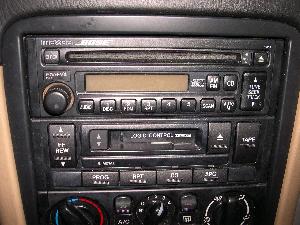
Description: This system is similar to the non-Bose, and includes a single-DIN head unit with an integrated AM/FM tuner and single-disc slot-loading CD player. The head unit sends a balanced line-level signal to a pair of separate single-channel 100-Watt amplifiers for the special Bose door speakers and tweeters.
Markings: This head unit has the number 1M31 or 1M37 on the face. The head unit says "Bose" on it, as do the door speaker covers.
History: These were introduced in 1998 and used through 2001.
Availability: 1998/9 cars with the Leather Package and 2000 and 2001 LS and Special Edition cars came with this unit standard. It was also available as a standalone option in 1999 on non-Leather Package cars. An add-on in-dash cassette player was a popular option.
More Information
Double-DIN NB Audio System (4162)
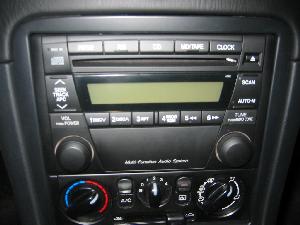
Description: This system includes a double-DIN head unit with an integrated AM/FM tuner and single-disc slot-loading CD player. The head unit includes a 4x25 (peak) Watt amplifier driving two speakers, one in each door. In-door tweeters could be added with the optional Convenience Package. The double-DIN units are "modular", meaning that an integrated casette deck or MiniDisc player can be added to the bottom and the single-disc CD player can be swapped out for a 6-CD changer on top.
Markings: The head unit has the number 4162 in the upper right hand corner of the display.
History: The 4162 was introduced in 2001, and a replacement with a silver face was introduced in 2004.
Availability: All 2001, 2002, and 2003 base model cars came with this unit standard including the 2003 Shinsen Version. Door tweeters are added with the Convenience Package (and on the Shinsen), and an in-dash 6-disc CD Changer, Cassette Player, or MiniDisc player are dealer-installed options. Note that the 2003 Club Sport package does not include a sound system at all.
More Information
Double-DIN NB Bose Audio System (4H60)
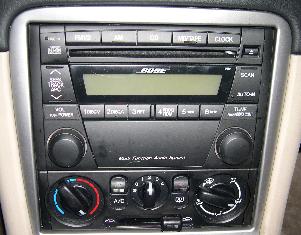
Description: This system includes a double-DIN head unit with an integrated AM/FM tuner and single-disc slot-loading CD player or in-dash 6-disc changer. The head unit has speed-sensitive volume control with three settings for top up and three more for top down. The head unit includes 4x25 (peak) Watt amplifiers, two of which send speaker-level audio to a pair of single-channel 100-Watt amplifiers behind the unit for the special Bose door speakers and tweeters. The double-DIN units are "modular", meaning that an integrated casette deck or MiniDisc player can be added to the bottom and the single-disc CD player can be swapped out for a 6-CD changer on top.
Markings: There is a small marking saying "4H60" in the upper right corner of the head unit face. The head unit says "Bose" on it, as do the door speaker covers.
History: The 4H60 was introduced in 2002, and a replacement with a silver face was introduced in 2004.
Availability: All 2002 and 2003 LS and Special Edition cars came with this unit standard. An in-dash 6-disc CD Changer, MiniDisc player, and Cassette deck are dealer-installed options for LS cars. The two 2002 Special Edition Miatas came with the 6-CD Changer standard, as did the 2003 Special Edition.
More Information
Double-DIN NB Silver Audio System (?)
Description: This system includes a double-DIN head unit with an integrated AM/FM tuner and single-disc slot-loading CD player. The head unit includes a 4x25 (peak) Watt amplifier driving two speakers, one in each door, and two windblocker speakers. In-door tweeters are added with the optional Convenience Package. The double-DIN units are "modular", meaning that an integrated casette deck or MiniDisc player can be added to the bottom and the single-disc CD player can be swapped out for a 6-CD changer or MP3-CD player on top.
Markings: This unit looks like the previous 4162, but has a silver/aluminum face, and replaces the "AM" button with one marked "SAT".
History: The silver systems were introduced in 2004.
Availability: All 2004 base cars came with this unit standard. Door tweeters are added with the Convenience Package, and an in-dash 6-disc CD Changer, MP3 CD player, Cassette Player, or MiniDisc player are dealer-installed options.
More Information
Double-DIN NB Bose Silver Audio System (4H64)
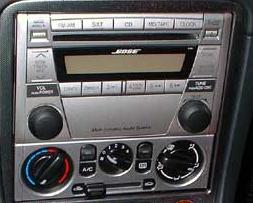
Description: This system includes a double-DIN head unit with an integrated AM/FM tuner and single-disc slot-loading CD player or in-dash 6-disc changer. The head unit has speed-sensitive volume control with three settings for top up and three more for top down. The head unit includes 4x25 (peak) Watt amplifiers, two of which are used for the door tweeters. Two other channels send speaker-level audio to a pair of single-channel 100-Watt amplifiers behind the unit for the special Bose door speakers. Mazda rates it as a "225-Watt" system. The double-DIN units are "modular", meaning that an integrated casette deck or MiniDisc player can be added to the bottom and the single-disc CD player can be swapped out for a 6-CD changer or MP3-CD player on top.
Markings: This unit looks like the previous 4H60, but has a silver/aluminum face and says "4H64" instead. It replaces the "AM" button with one marked "SAT". The head unit says "Bose" on it, as do the door speaker covers.
History: The silver systems were introduced in 2004.
Availability: All 2004 LS cars and the Mazdaspeed MX-5 came with this unit standard. An in-dash 6-disc CD Changer, MP3 CD player, MiniDisc player and Cassette Player are dealer-installed options.
More Information
Q) So which cars have which audio components?
A) Here’s a complete list:
- '98/99 base
- Single-DIN (1M32)
- Door speaker (x2)
- '98/99 base with Popular Equipment Package
- Single-DIN (1M32)
- Door speaker (x2)
- Door tweeter (x2)
- '98/99 base with Bose option, Leather Package and 10th Anniversary
- Single-DIN Bose (1M31)
- Bose 100 Watt Single-Channel Amplifier (x2)
- Bose Door speaker (x2)
- Door tweeter (x2)
- '00 base
- Single-DIN (4M32)
- Door speaker (x2)
- '00 base with Convenience Package
- Single-DIN (4M32)
- Door speaker (x2)
- Door tweeter (x2)
- '00 LS and Special Edition
- Single-DIN Bose (1M31)
- Bose 100 Watt Single-Channel Amplifier (x2)
- Bose Door speaker (x2)
- Door tweeter (x2)
- '01 base
- Double-DIN (4162)
- Door speaker (x2)
- '01 base with Convenience Package
- Double-DIN (4162)
- Door speaker (x2)
- Door tweeter (x2)
- '01 LS and Special Edition
- Single-DIN Bose (1M37)
- Bose 100 Watt Single-Channel Amplifier (x2)
- Bose Door speaker (x2)
- Door tweeter (x2)
- '02 base
- Double-DIN (4162)
- Door speaker (x2)
- '02 base with Convenience Package
- Double-DIN (4162)
- Door speaker (x2)
- Door tweeter (x2)
- '02 LS and Special Edition
- Double-DIN (4H60) with Speed-Sensing Volume Control
- Bose 100 Watt Single-Channel Amplifier (x2)
- Bose Door speaker (x2)
- Door tweeter (x2)
- '03 base
- Double-DIN (4162)
- Door speaker (x2)
- '03 base with Convenience Package and Shinsen Version
- Double-DIN (4162)
- Door speaker (x2)
- Door tweeter (x2)
- '03 LS and Special Edition
- Double-DIN (4H60) with Speed-Sensing Volume Control
- Bose 100 Watt Single-Channel Amplifier (x2)
- Bose Door speaker (x2)
- Door tweeter (x2)
- '04 base
- Double-DIN Silver (?)
- Door speaker (x2)
- Windblocker speaker (x2)
- '04 base with Convenience Package or Azure Blue Cloth Package
- Double-DIN Silver (?)
- Door speaker (x2)
- Windblocker speaker (x2)
- Door tweeter (x2)
- '04 LS and Mazdaspeed MX-5
- Double-DIN Silver (4H64) with Speed-Sensing Volume Control
- Bose 100 Watt Single-Channel Amplifier (x2)
- Bose Door speaker (x2)
- Door tweeter (x2)
- Bose Windblocker speaker (x2)
Specifics about NB OEM Single-DIN Non-Bose Audio Systems
Q) Can you tell me more about this unit?
A) There are actually two similar head units, the 1M32 (made by Panasonic) from the ‘98/’99 cars and the 4M32 (made by FMS) from the ’00 cars. These head units include an internal 4-channel amp and are also used in other Mazda products, like the Protégé. The amp is rated to 25 Watts peak power at 4 ohms, which is 12 Watts RMS.
The 1M32 has a switch on the bottom in the rear (inside the dash) that changes it from 2 to 4 channels and enables the fader feature. You must unplug the unit entirely before flipping the switch, or the change will not be registered by the head unit.
The 4M32 looks similar to the 1M32, but does not have the switch to enable 4-channel mode. Instead, just press "Audio" for 5 seconds and 4-channel mode will be enabled. There is a page of information available about this unit. If you are installing this unit in another vehicle, this post has more information. And this post gives details on installing it in an NA as does this one.
Q) Can I replace the speakers?
A) Yes, and it's an easy upgrade, and can be cheap (if you are)! Most 6x8 or 5x7 speakers will fit in the doors, and you can just swap out the old speaker for the new one. 8-inch round components will also fit with some (non-metal) modifications. There is quite a bit of room in the doors. You will probably want to add an amplifier, too. If so, use one with speaker-level inputs if you want to retain the stock head unit because there is no line-level output.
Q) I don't have the tweeters, how hard is it to add them?
A) It's not too hard, apart from wiring up a crossover. It's not plug and play, so you have to figure out where to put a crossover and run some wires. The doors are NOT pre-wired for tweeters, sadly. You can put a crossover in the door, which makes wiring easier but is risky (moisture could get on it). Or you could put it inside the dash which makes it much trickier to run the wires. More information
Q) Can I add rear/windblocker speakers?
A) Yes, see this thread. Here is some more information about adding windblocker speakers. And a writeup with pictures.
The 2004 factory windblocker with speakers might look like a tempting choice, but it's not really a reasonable one at this point. Other Miata.Netters have looked into it, and found them very expensive. The standard windblocker with speakers costs $687.05, while the Bose one costs $1236.45. Street price is somewhat cheaper, but not enough to make it competative with a decent aftermarket setup. Also, they're just 2" speakers, nothing special.
Q) Can I replace the head unit?
A) Yes, and it's easy, too. Just buy a wiring kit with your new head unit and go to town.
Q) Which wiring harness do I need?
A) Metra makes a pair of two-connector sets:
- 70-7901 plugs into the car's harness.
- 71-7901 plugs into the head unit's socket.
Scosche also makes a connector:
- MA02 plugs into the car's harness.
Q) What is the pinout for the speaker connector?
A) The single-DIN units use an entirely different set of connectors than the double-DIN units. This head unit has three connectors on the back. From left to right (looking at the back) are: CN200 (the casette connector), CN701 (the main harness connector), and CN702 (the rear speaker connector). Pinouts are available at Miata.Net.
Q) Can I add a CD Changer?
A) Yes, you can use an OEM changer or buy an adapter for an Alpine M-Bus changer.
Q) Can I add a casette deck (or remove the one I have)?
A) Yes, the Mazda in-dash casette deck (part number NC75-79-9D0) works fine with this head unit. The retail price is $215, but Trussville Mazda charges $168. It's fairly easy to install, but requires removing your head unit.
If you don't like having a casette deck, you can install a storage box (part number B02A-66-9M0A) in its place. MSRP $11.15.
Q) Can I add an Auxiliary Input?
A) Surprisingly, this is also a simple mod! Note that the pins you will need to tap just happen to fit the power/hard drive LED/speaker/keylock connectors used to connect PC motherboards to cases. Dig up an old computer case and cut off the female pigtails, and use these instead of trying to solder to the pins directly.
Specifics about NB OEM Single-DIN Bose Audio Systems
Q) Can you tell me more about this unit?
A) The head unit looks similar to the Non-Bose from the
same year, but there are some major differences. The 1M31 model does not have
ANY internal amplifiers, and the 1M37 probably does not, either. The system
includes a pair of external 100 Watt Bose amplifiers (connected through a
balanced line out) to drive the Bose door speakers and tweeters. There is
a lot more great information, including acoustic measurements, here.
Q) My Bose stereo sounds terrible!
A) Most people think the Bose system sounds pretty bad, and after 3 months with my car I tend to agree. With the bass and treble controls set at the default positions, the radio has boomy, poorly-defined bass and too much treble, but no midrange. I set the treble control down two "blocks" and the bass almost all the way down to get halfway decent sound. But it's still boomy sometimes!
Also, there is a known problem with the early ('99) Bose door speakers. They tend to get wet, and when they do, they start to buzz like blown Wal Mart specials. Your dealer will probably install a set of baffles to keep them dry if you complain, or you could order some baffles from a place like Crutchfield or a local car audio shop and put them in yourself. This will help, but some folks like to install some dynamat-like sound dampener in the door panels in addition to help keep the buzzing down further.
Q) How are the speakers wired?
A) The speakers use a single wire pair from the Bose amp in the dash through to the doors. This is then spliced to provide signal for both the tweeter and door speaker. This can cause trouble if you plan to replace the speakers and amp and re-use the existing wiring - you would need to put a crossover in the doors! This is something most folks would rather avoid because the Miata doors can be somewhat moist. this post has more information on the topic.
Q) Can I replace the speakers?
A) The Bose amp must not be used to drive normal non-Bose speakers since the Bose speakers are a special .5 Ohm type. However, there is now a new solution from Clearwater which includes much better speakers for Bose systems.
You can add an aftermarket amp and speakers together, however. See this post for more information.
Q) Can I replace the Bose amplifier and use the stock head unit?
A) Yes, but the Bose head unit puts out two balanced, isolated channels. See this post for more information. There are adapters available for this application, too. It is possible to drive the .5 Ohm Bose speakers with an appropriate aftermarket amp, but you will probably want to replace the speakers, too. More Information
Q) Can I replace the head unit?
A) Yep - here's some information, and here’s some more. Here's another great thread. Most people bypass the Bose amps and replace the speakers when doing this, effectively removing the entire OEM sound system.
Q) Which wiring harness do I need?
A) Metra makes a pair of two-connector sets:
- 70-7901 plugs into the car's harness.
- 71-7901 plugs into the head unit's socket.
Scosche also makes a connector:
- MA02 plugs into the car's harness.
Q) What is the pinout for the speaker connector?
A) The single-DIN units use an entirely different set of connectors than the double-DIN units. This head unit has three connectors on the back. From left to right (looking at the back) are: CN200 (the casette connector), CN701 (the main harness connector), and CN702 (the rear speaker connector). Pinouts are available at Miata.Net.
Q) Can I add rear/windblocker speakers?
A) The 1M31 model does not have the rear speaker capabilities. The 1M37 probably does not either. So the only way to do this is to replace the Bose amplifier.
The 2004 factory windblocker with speakers might look like a tempting choice, but it's not really a reasonable one at this point. Other Miata.Netters have looked into it, and found them very expensive. The standard windblocker with speakers costs $687.05, while the Bose one costs $1236.45. Street price is somewhat cheaper, but not enough to make it competative with a decent aftermarket setup. Also, they're just 2" speakers, nothing special.
Q) Can I add a CD Changer?
A) For the 1M31, yes, see above. The 1M37 does not seem to have the CD Changer jack!
Q) Can I add a casette deck (or remove the one I have)?
A) Yes, see above.
Q) Can I add an Auxiliary Input?
A) Yes, see above.
Specifics about NB OEM Double-DIN Non-Bose Audio Systems
Q) Can you tell me more about this unit?
A) The head unit (4162) actually includes an internal 4-channel 25 (peak) Watt amplifier. It drives the door speakers and optional tweeters, wired in parallel, directly with two channels. The other two are unused but the fader is enabled, unlike the Bose unit.
I have obtained a block wiring diagram for this unit.
Q) How do I remove the head unit?
A) See below.
Q) Can I replace the speakers?
A) Yes, and it's an easy upgrade, and can be cheap (if you are)! Most 6x8 or 5x7 speakers will fit in the doors, and you can just swap out the old speaker for the new one. 8-inch round components will also fit with some (non-metal) modifications.
Q) Can I replace the head unit?
A) You'll need a mounting bracket, and I would get a wiring harness adapter, but it shouldn't be a problem.
Some folks might be tempted to try to install the Bose unit in a non-Bose car. This is probably a bad idea - it would cost a lot, entail lots of work, and the Bose unit really doesn't sound too great. Any decent aftermarket setup, especially one with an external amp, is going to work out a lot better!
Q) Which wiring harness do I need?
A) Metra makes a pair of connectors:
- 70-7903 plugs into the car's harness.
- 71-7903 plugs into the head unit. (this connector is hard to find!)
Scosche also makes a pair of connectors:
- MA03 plugs into the car's harness.
- MA03R plugs into the head unit's socket.
Q) What is the pinout for the speaker connector?
A) The single-DIN units use an entirely different set of connectors than the double-DIN units. There are two connectors on the back of the double-DIN unit, but only the larger one (on the left, looking at the back of the unit) is used. Here is the connector pinout. This is the socket on the head unit. See also the general Mazda pinout for advanced/extra functions.

| PIN |
APPLICATION |
COLOR |
| A |
LF+ |
Yellow/Red |
| B |
Bat (+12V) |
Blue/Red |
| C |
LF- |
Yellow/Black |
| D |
RF+ |
Yellow/Green |
| E |
Pulsed Dimmer (TNS+) |
Red/Black |
| F |
RF- |
Green |
| G |
Inverted Dimming |
Grey/Red |
| H |
PWR Ant |
Grey/Black |
| I |
blank |
|
| J |
blank |
|
| K |
blank |
|
| L |
Tele mute |
|
| M |
blank |
|
| N |
blank |
|
| O |
blank |
|
| P |
blank |
|
| Q |
blank |
|
| R |
IGN (+12V switched) |
Blue/Black |
| S |
LR+ |
|
| T |
blank |
|
| U |
LR- |
|
| V |
RR+ |
|
| W |
Ground |
Black |
| X |
RR- |
|
Thanks to Jeff Anderson!
Q) I don't have the tweeters, how hard is it to add them?
A) It's not too hard, apart from wiring up a crossover. It's not plug and play, so you have to figure out where to put a crossover and run some wires. The doors are NOT pre-wired for tweeters, sadly. You can put a crossover in the door, which makes wiring easier but is risky (moisture could get on it). Or you could put it inside the dash which makes it much trickier to run the wires. More information
The factory, and most modders, wire them in parallel with the regular door speakers. However, you could also wire them up to the (unused) rear speaker connector on the head unit and use the fader to control them. I don't know of anyone who has attempted this, but it should work, apart from the trouble running new wires from the head unit to the tweeters.
Q) Can I add rear/windblocker speakers?
A) Probably, and you will not (necessarily) need an external amplifier to drive them, unlike the Bose unit. The 4H60 does not have the rear speakers and fader enabled, but the 4162 does! Here is some more information about adding windblocker speakers. This cardomain page has photos of this operation.
The 2004 factory windblocker with speakers might look like a tempting choice, but it's not really a reasonable one at this point. Other Miata.Netters have looked into it, and found them very expensive. The standard windblocker with speakers costs $687.05, while the Bose one costs $1236.45. Street price is somewhat cheaper, but not enough to make it competative with a decent aftermarket setup. Also, they're just 2" speakers, nothing special.
Q) Can I add a CD Changer?
A) Yes, the Mazda in-dash 6-CD changer is a modular component and works fine with this head unit. The part number is TC87-79-EG0, and the retail is $540. Rosenthal Mazda sells it for $455. The 6-CD changer from my 2002 MPV (part number LD51-79-EG0) worked fine in my 2003 Miata Bose unit (4H60), and Rosenthal only wants $429 for that. You also need a plastic bezel to allow access to the (currently hidden) "load" button on the head unit. The MPV bezel is not correct for the Miata.
The 2004 MP3 player almost certainly will not work since the head unit lacks the correct display. I doubt any non-OEM changers would work, since there is no changer connector on the back.
Q) Can I add a casette deck?
A) Yes, the Mazda in-dash casette deck (part number N068-79-AD0) is a modular component and works fine with this head unit. The retail price is $215, but Trussville Mazda charges $168. You need to make sure it comes with the correct front bezel (which includes the eject button and casette door) for the Miata. It's fairly easy to install, but requires removing your head unit. The casette deck and bezel from my 2002 MPV (part number LD52-79-AD0, retail $215) worked fine in my 2003 Miata Bose unit (4H60).
Q) Can I add a minidisc player?
A) Yes, the Mazda in-dash minidisc player (part number N069-79-AP0) is a modular component and works fine with this head unit. The retail price is $550, but Trussville Mazda charges $432.95 for the MPV minidisc player (part number L134-79-AP0). The casette deck and bezel from my 2002 MPV worked fine in my 2003 Miata Bose unit (4H60), so I bet this Minidisc player and bezel will work, too.
Q) Can I add an Auxiliary Input?
A) There is only ONE way to add an auxiliary input to the double-DIN head units, and it isn't pretty. But it should work... How about an FM modulator?
Specifics about NB OEM Double-DIN Bose Audio Systems
Q) Can you tell me more about this unit?
A) The head unit is similar to the Non-Bose.
The Bose version of the head unit adds Speed-Sensing Volume Control with three top-down settings and three top-up settings. These are numbered 1 through 3, where 1 boosts the volume a little as speed climbs and 3 boosts it much more. The top-down settings seem to cut the bass, while the top-up settings don’t. This works much better than the Automatic Level Control in the old MSSS. I think I can hear discrete steps as the car passes certain speed thresholds, the most noticeable being around 65mph.
The Bose amp is rated to 100 Watts per channel driving .5 Ohm speakers. The amplifiers (it's a pair of single-channels) are driven with speaker-level outputs from the head unit. They drive both the door speakers and the tweeters in parallel. The tweeters appear to have built-in crossovers, but I'm not sure about this. Pin J on the harness controls a relay that sends power to the amp, and you can hear the relay click (to the left of the steering column) whenever you turn on the stereo.
I have obtained a block wiring diagram for this unit.
Q) My Bose stereo sounds terrible!
A) Most people think the Bose system sounds pretty bad, and after 3 months with my car I tend to agree. With the bass and treble controls set at the default positions, the radio has boomy, poorly-defined bass and too much treble, but no midrange. I set the treble control down two "blocks" and the bass almost all the way down to get halfway decent sound. But it's still boomy sometimes!
Even though the later Bose systems aren't supposed to be affected by the infamous Bose Buzz that affected the '99 cars, many people (including myself) do hear a distinct buzz from the door speakers in wet weather. The '99 problem was caused by a missing or incorrect baffle, and Bose admitted that the speakers will buzz when damp. So it's possible that, even with the correct baffle, the speakers might get damp and buzz. You can try waterproofing them (inside the door) to cure this problem. Lots of folks install 8" baffles from Crutchfield for this purpose.
Q) My 2002 power antenna stopped working!
A) There's a TSB about this problem. It affects early 2002 cars with the modular Bose radio.
Q) How do I remove the head unit?
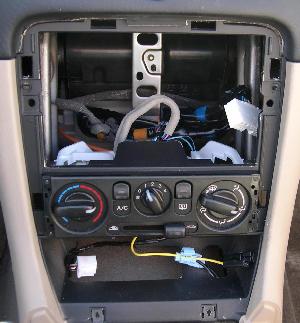
A) Here's a step by step method:
It might make it easier to remove the trim surrounding the head unit. To
do that, you have to remove the center console, too. Once you're familiar with the internal bits, you should be able to remove the head unit without touching the trim - I can pull the head unit in about 30 seconds!
One warning: When you disconnect the main harness, the head unit will lose all it's programming. You might want to write down your radio station presets...
Here's how to remove the center console:
- Use a phillips screwdriver to unscrew the two screws in the storage box (by your elbow).
- Next, pop open the covers on the two screws on each side of the console by your knee.
- Finally, pry the window switches up with a thin, wide screwdriver and unscrew the screw beneath it.
- Disconnect the power connector on the window switch unit and squeeze the tabs on the black connector anchoring this cable to the console to release it.
- Unscrew the shift knob.
- Left the console at the front, open the storage box, and guide the trunk and gas levers through the rubber flap as you pull the console forward.
- Set the console aside.
Now you can remove the trim surrounding the radio and heating controls. Here's how to remove the trim:
- Unscrew the two screws at the bottom.
- Now pry the surround out, starting from
the bottom. There are clips on each side right above the airbag switch,
another set on each side of the radio, and a third set above the radio. You
can pry the surround out from the inside with a wide, flat screwdriver.
- When
all the clips have released, unclip the airbag switch connector and the
lighter power connector.
- Now set the surround aside.
Now here's how to remove the head unit:
- On each side of the radio are long covers that look like part of the radio face but aren't. Use a narrow flat screwdriver to pry these off from the bottom and top.
- When they release, you will see 5 round holes on each side of the radio. You should use two sets of "radio puller" tools to pull the unit out, but if you don't have these, you can use 8 nails. Just stick them into four holes on each side (skip one of the two that are right near each other) and the clip holding the radio in place will release.
- Then pull the unit out. It will come out a few inches and feel like it doesn't want to come further. Just pull harder.
- The whole thing will come out and you can unplug the antenna (on the driver's side) and the other connections (on the passenger's side). The connection bundle is released with a lever on the bottom.
Reassembly is the reverse of disassembly. Be careful to put the insulation
back around the shfter just as it was. You will also have to reprogram the
radio. No, this radio doesn't have a theft code that disables it after you
remove it from the car.
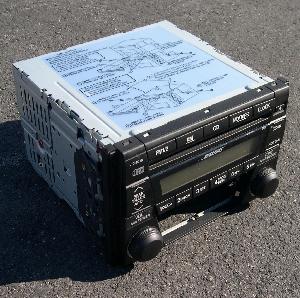
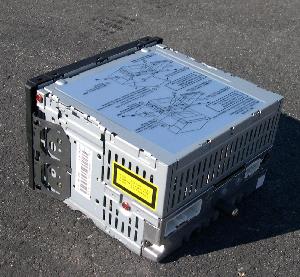
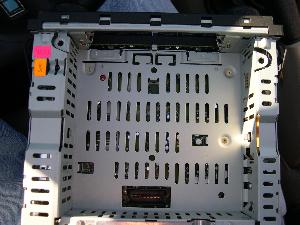
Q) Can I replace the speakers?
A) The Bose amp must not be used to drive normal non-Bose speakers since the Bose speakers are a special .5 Ohm type. However, there is now a new solution from Clearwater which includes much better speakers for Bose systems.
You can add an aftermarket amp and speakers together, however. Since the head unit includes a built-in amplifier, you could also probably re-wire it to drive aftermarket speakers directly (like the non-Bose) but this would probably not be worth doing.
Q) Can I replace the Bose amplifier and use the stock head unit and speakers?
A) Yes. The Double-DIN Bose head unit puts out speaker-level output just like the non-Bose unit. Just use a speaker-level amp, and you're all set. Some folks have reported success driving the stock Bose speakers with aftermarket amps, but most people would replace the speakers, too, since they're not too great.
Q) Can I replace the head unit?
A) Yes, with a proper mounting bracket and wiring harness. The Bose amplifier can take speaker-level inputs from your new head unit, so you don't have to change out the amp and speakers, but you might want to do it anyway. You might need an attenuator (like a Scosche) if you do this to avoid over-driving the Bose amplifier.
Q) Which wiring harness do I need?
A) Metra makes a pair of connectors:
- 70-7903 plugs into the car's harness.
- 71-7903 plugs into the head unit. (this connector is hard to find!)
Scosche also makes a pair of connectors:
- MA03 plugs into the car's harness.
- MA03R plugs into the head unit's socket.
Q) What is the pinout for the speaker connector?
A) The single-DIN units use an entirely different set of connectors than the double-DIN units. There are two connectors on the back of the double-DIN unit, but only the larger one (on the left, looking at the back of the unit) is used. Here is the connector pinout. This is the socket on the head unit. See also the general Mazda pinout for advanced/extra functions.

| PIN |
APPLICATION |
COLOR |
| A |
LF+ |
Red |
| B |
Bat (+12V) |
Blue/Red |
| C |
LF- |
White |
| D |
RF+ |
Yellow |
| E |
Pulsed Dimmer (TNS+) |
Red/Black |
| F |
RF- |
Orange |
| G |
Inverted Dimming |
Grey/Red |
| H |
PWR Ant |
Grey/Black |
| I |
Speed Pulse |
Green/Red |
| J |
Amp Remote |
Light Green/Black |
| K |
blank |
|
| L |
Tele mute |
|
| M |
blank |
|
| N |
blank |
|
| O |
blank |
|
| P |
blank |
|
| Q |
blank |
|
| R |
IGN (+12V switched) |
Blue/Black |
| S |
LR+ |
Not Enabled |
| T |
blank |
|
| U |
LR- |
Not Enabled |
| V |
RR+ |
Not Enabled |
| W |
Ground |
Black |
| X |
RR- |
Not Enabled |
Thanks to Jeff Anderson!
Q) Can I add rear/windblocker speakers?
A) Probably, though you will need an external amplifier to drive them. The Bose unit does not have the rear speaker outputs activated (I verified this on my own 4H60), though there might be some way to activate them (and the fader function). You can replace the Bose amps with an external, speaker-level 4-channel amplifier to drive new (non-Bose) door speakers and tweeters as well as new rear speakers. Here is some more information about adding windblocker speakers. This cardomain page has photos of this operation.
The 2004 factory windblocker with speakers might look like a tempting choice, but it's not really a reasonable one at this point. Other Miata.Netters have looked into it, and found them very expensive. The standard windblocker with speakers costs $687.05, while the Bose one costs $1236.45. Street price is somewhat cheaper, but not enough to make it competative with a decent aftermarket setup. Also, they're just 2" speakers, nothing special.
Q) Can I add a CD Changer?
A) Yes, see above.
Q) Can I add a casette deck?
A) Yes, see above.
Q) Can I add a minidisc player?
A) Yes, see above.
Q) Can I add an Auxiliary Input?
A) Yes, see above.
Specifics about NB OEM Double-DIN Silver Non-Bose Audio Systems
Q) Can you tell me more about this unit?
A) Not much is (yet) known about this unit. It seems similar to the previous units, but has a silver face, re-worked display, and replaces the “AM” button with one that says “SAT”. Maybe there will be a satellite radio option?
Q) Can I replace the speakers?
A) Probably.
Q) Can I replace the head unit?
A) Probably.
Q) Which wiring harness do I need?
A) Metra makes a pair of connectors:
- 70-7903 plugs into the car's harness.
- 71-7903 plugs into the head unit. (this connector is hard to find!)
Scosche also makes a pair of connectors:
- MA03 plugs into the car's harness.
- MA03R plugs into the head unit's socket.
Q) What is the pinout for the speaker connector?
A) The single-DIN units use an entirely different set of connectors than the double-DIN units. There are two connectors on the back of the double-DIN unit, but only the larger one (on the left, looking at the back of the unit) is used. See the general Mazda pinout for advanced/extra functions.
Q) Can I add rear/windblocker speakers?
A) 2" full-range windblocker speakers are standard on all ’04 Miatas. Early reports are not positive, however, and claim that the speakers are barely audible.
Q) Can I add a CD Changer?
A) Yes, the Mazda in-dash 6-CD changer (part number GJ6D-79-EGX) is a modular component and works fine with this head unit. Rosenthal Mazda charges $429 for the 6-CD changer, and you also need to buy the trim panel, which is just a piece of plastic (part number N101-79-BGX) for $17.95.
The 2004 MP3 CD player (part number GJ6B-79-AGXB) is another option. Rosenthal Mazda charges $273 for the MP3 CD player, and you also need to buy the trim panel, which is just a piece of plastic (part number N103-79-BGX) for $17.95.
Q) Can I add a casette deck?
A) Yes, the Mazda in-dash casette deck (part number GJ6A-79-ADX) is a modular component and works fine with this head unit. The retail price is unknown, but Rosenthal Mazda charges $130. You also need to buy the correct front bezel, which has a button and casette door (part number N104-79-BCX) for the 2004 Miata, which is another $50. It's fairly easy to install, but requires removing your head unit.
Q) Can I add a minidisc player?
A) Yes, the Mazda in-dash minidisc player (part number GJ6E-79-APX) is a modular component and works fine with this head unit. You also need the trim panel (part number N105-79-BCX).
Q) Can I add an Auxiliary Input?
A) Maybe.
Specifics about NB OEM Double-DIN Silver Bose Audio Systems
Q) Can you tell me more about this unit?
A) The unit looks somewhat like the previous black unit, but says "4H64" instead.
Q) My Bose stereo sounds terrible!
A) Most people think the Bose system sounds pretty bad, and after 3 months with my car I tend to agree. With the bass and treble controls set at the default positions, the radio has boomy, poorly-defined bass and too much treble, but no midrange. I set the treble control down two "blocks" and the bass almost all the way down to get halfway decent sound. But it's still boomy sometimes!
Even though the later Bose systems aren't supposed to be affected by the infamous Bose Buzz that affected the '99 cars, many people (including myself) do hear a distinct buzz from the door speakers in wet weather. The '99 problem was caused by a missing or incorrect baffle, and Bose admitted that the speakers will buzz when damp. So it's possible that, even with the correct baffle, the speakers might get damp and buzz. You can try waterproofing them (inside the door) to cure this problem. Lots of folks install 8" baffles from Crutchfield for this purpose.
Q) Can I replace the speakers?
A) Probably.
Q) Can I replace the Bose amplifier and use the stock head unit and speakers?
A) Probably.
Q) Can I replace the head unit?
A) Probably.
Q) Which wiring harness do I need?
A) Metra makes a pair of connectors:
- 70-7903 plugs into the car's harness.
- 71-7903 plugs into the head unit. (this connector is hard to find!)
Scosche also makes a pair of connectors:
- MA03 plugs into the car's harness.
- MA03R plugs into the head unit's socket.
Q) What is the pinout for the speaker connector?
A) The single-DIN units use an entirely different set of connectors than the double-DIN units. There are two connectors on the back of the double-DIN unit, but only the larger one (on the left, looking at the back of the unit) is used. See the general Mazda pinout for advanced/extra functions.
Q) Can I add rear/windblocker speakers?
A) 2" full-range windblocker speakers are standard on all ’04 Miatas. Early reports are not positive, however, and claim that the speakers are barely audible.
Q) Can I add a CD Changer?
A) Yes, see above.
Q) Can I add a casette deck?
A) Yes, see above.
Q) Can I add a minidisc player?
A) Yes, see above.
Q) Can I add an Auxiliary Input?
A) Maybe.
Q) What is the general pinout for all Mazda cars?
Here is the large connector pinout for all known pins on all Mazda cars. Note that not all of these are connected or do anything on any particular radio. This is a combination of all cars... (this is the socket on the head unit)

| PIN |
APPLICATION |
2003 Miata |
2003 Miata Bose |
2003 MPV |
2003 Protege |
2004 RX-8 |
| A |
Left Front + |
Yellow/Red |
Red |
Blue/Orange |
Black/Red |
Red/Blue |
| B |
Battery (+12V) |
Blue/Red |
Blue/Red |
Blue/Red |
Blue/Red |
Blue/Red |
| C |
Left Front - |
Yellow/Black |
White |
Violet |
Black/White |
Light Green/Red |
| D |
Right Front + |
Yellow/Green |
Yellow |
White/Red |
Red |
Blue/White |
| E |
Pulsed Dimmer (TNS+) |
Red/Black |
Red/Black |
Light Green/Blue |
Light Green/Blue |
Red/Yellow |
| F |
Right Front - |
Green |
Orange |
White |
White |
Yellow/Green |
| G |
Inverted Dimming |
Grey/Red |
Grey/Red |
White/Blue |
White/Blue |
Grey/Red |
| H |
PWR Ant |
Grey/Black |
Grey/Black |
|
|
Yellow/White |
| I |
Speed Pulse |
|
Green/Red |
|
|
Green/Red |
| J |
Amp Remote |
|
Light Green/Black |
White |
Yellow (woofer?) |
Purple/Blue |
| K |
Nav: Parking Brake |
|
|
|
|
Yellow/Green |
| L |
Telephone Mute |
|
|
|
|
|
| M |
Nav: Reverse |
|
|
|
|
Blue/White |
| N |
Clockspring/Wheel Controls |
|
|
Grey/Black |
|
Red/Black |
| O |
blank |
|
|
|
|
|
| P |
Clockspring/Wheel Controls |
|
|
White/Green |
|
Green/White |
| Q |
blank |
|
|
|
|
|
| R |
IGN (+12V switched) |
Blue/Black |
Blue/Black |
Purple/Blue |
Purple/Black |
Green/Orange |
| S |
Left Rear + |
|
|
Green/Orange |
Brown/White |
Green/Orange |
| T |
blank |
|
|
|
|
Black/White |
| U |
Left Rear - |
|
|
Green |
Brown |
Blue/Orange |
| V |
Right Rear + |
|
|
Yellow/Black |
Green |
Grey/Red |
| W |
Ground |
Black |
Black |
Black |
Black |
Black |
| X |
Right Rear - |
|
|
Purple |
Green/Orange |
Brown/Red |
Thanks Tobias Albert.
Q) You don't know what you're talking about with this radio stuff.
How can I set you straight?
A) PLEASE contribute! If you have any more info, send it along! My email address is sfoskett@slf.gweep.net. This FAQ also has a home at slf.gweep.net.
Also, please note that all of this information applies to the US Miatas, but some may not be correct for the Miatas in other countries. I'm not even sure if this radio was available in places other than the US! If you have anything about non-US radios to contribute, please do so!








